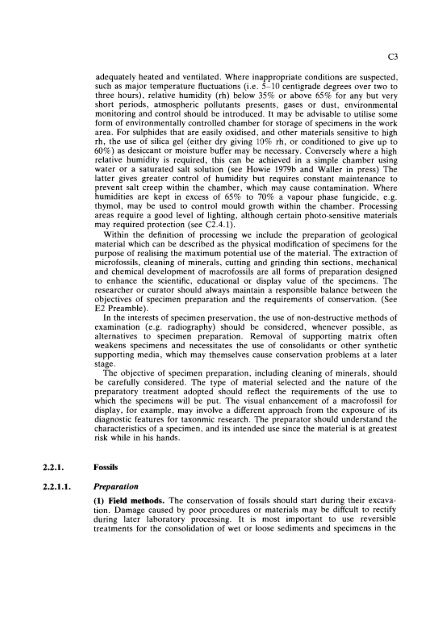GUIDELINES FOR THE CURATION OF GEOLOGICAL MATERIALS
GUIDELINES FOR THE CURATION OF GEOLOGICAL MATERIALS
GUIDELINES FOR THE CURATION OF GEOLOGICAL MATERIALS
You also want an ePaper? Increase the reach of your titles
YUMPU automatically turns print PDFs into web optimized ePapers that Google loves.
adequately heated and ventilated. Where inappropriate conditions are suspected,<br />
such as major temperature fluctuations (i.e. 5-10 centigrade degrees over two to<br />
three hours), relative humidity (rh) below 35% or above 65% for any but very<br />
short periods, atmospheric pollutants presents, gases or dust, environmental<br />
monitoring and control should be introduced. It may be advisable to utilise some<br />
form of environmentally controlled chamber for storage of specimens in the work<br />
area. For sulphides that are easily oxidised, and other materials sensitive to high<br />
rh, the use of silica gel (either dry giving 10% rh, or conditioned to give up to<br />
60%) as desiccant or moisture buffer may be necessary. Conversely where a high<br />
relative humidity is required, this can be achieved in a simple chamber using<br />
water or a saturated salt solution (see Howie 1979b and Waller in press) The<br />
latter gives greater control of humidity but requires constant maintenance to<br />
prevent salt creep within the chamber, which may cause contamination. Where<br />
humidities are kept in excess of 65% to 70% a vapour phase fungicide, e.g.<br />
thymol, may be used to control mould growth within the chamber. Processing<br />
areas require a good level of lighting, although certain photo-sensitive materials<br />
may required protection (see C2.4.1).<br />
Within the definition of processing we include the preparation of geological<br />
material which can be described as the physical modification of specimens for the<br />
purpose of realising the maximum potential use of the material. The extraction of<br />
microfossils, cleaning of minerals, cutting and grinding thin sections, mechanical<br />
and chemical development of macrofossils are all forms of preparation designed<br />
to enhance the scientific, educational or display value of the specimens. The<br />
researcher or curator should always maintain a responsible balance between the<br />
objectives of specimen preparation and the requirements of conservation. (See<br />
E2 Preamble).<br />
In the interests of specimen preservation, the use of non-destructive methods of<br />
examination (e.g. radiography) should be considered, whenever possible, as<br />
alternatives to specimen preparation. Removal of supporting matrix often<br />
weakens specimens and necessitates the use of consolidants or other synthetic<br />
supporting media, which may themselves cause conservation problems at a later<br />
stage.<br />
The objective of specimen preparation, including cleaning of minerals, should<br />
be carefully considered. The type of material selected and the nature of the<br />
preparatory treatment adopted should reflect the requirements of the use to<br />
which the specimens will be put. The visual enhancement of a macrofossil for<br />
display, for example, may involve a different approach from the exposure of its<br />
diagnostic features for taxonmic research. The preparator should understand the<br />
characteristics of a specimen, and its intended use since the material is at greatest<br />
risk while in his hands.<br />
Fossils<br />
Preparation<br />
(1) Field methods. The conservation of fossils should start during their excavation.<br />
Damage caused by poor procedures or materials may be diffcult to rectify<br />
during later laboratory processing. It is most important to use reversible<br />
treatments for the consolidation of wet or loose sediments and specimens in the

















